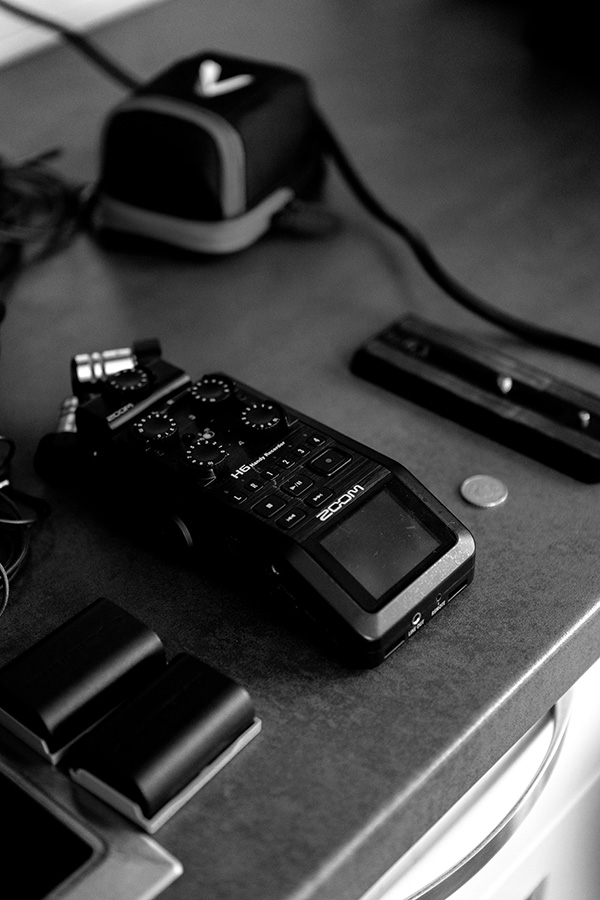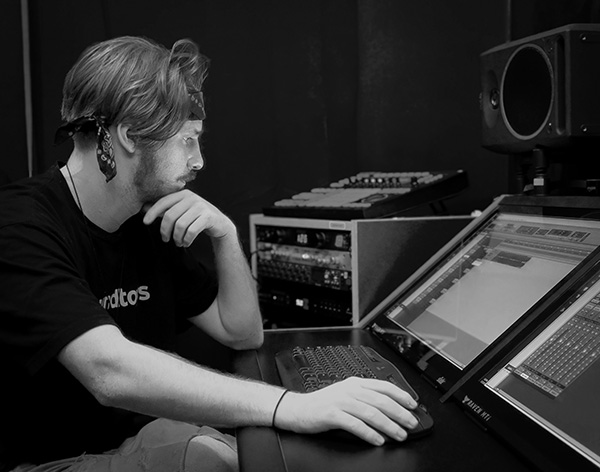A sound designer is an individual who creates and manipulates audio elements to enhance the overall experience of a media production, such as films, television shows, video games, and theater productions.
Tasks of a Sound Designer
History of Sound Design
Famous Sound Designer
Sound Design Tips & Techniques
Tasks of a Sound Designer
Creating Sound Effects
Sound designers are responsible for creating and designing unique sound effects that complement the visuals and enhance the narrative of a production.
Choosing, Editing, and Remixing Music
Sound designers collaborate with composers or live musicians to select, edit, and remix music that fits the project’s story and atmosphere.
Building Atmosphere
Sound designers use soundscapes, ambiances, and other audio elements to build atmosphere and mood in a production.
Managing Sound Equipment
Sound designers handle and operate small audio equipment, such as soundboards and playback machines, to cue and control the right sounds at the appropriate time.
Collaborating with Directors and Artists
Sound designers work closely with directors, artists, and other members of the creative team to ensure that the sound supports and enhances the storytelling of the production.
Organizing and Managing Projects
Organizational skills are crucial for sound designers to manage their time, prioritize tasks, and keep track of projects and audio recordings.
Working with Performers
Sound designers collaborate with actors and performers to mic them properly, ensure clarity in their performances, and create a balanced audio experience for the audience.
History of Sound Design
The term “sound design” has been around for several decades, but its use has become more prevalent in recent years. The history of sound design can be traced back to various industries, including film, theater, and other forms of media. Here is a brief overview of the history of sound design:
Film
In the film industry, sound design gained recognition in the late 1970s. The term “sound designer” was used for the first time in film in 1979. Sound design pioneers such as Walter Murch, Ben Burtt, and Gary Rydstrom played significant roles in advancing the field of sound design in cinema. They introduced innovative techniques and pushed for sound to be recognized as a crucial element in filmmaking.
Theater
Sound design in theater has a different focus compared to film. It refers to the selection of music and sounds for a stage production, as well as the setup and use of live audio technology during performances. The role of a sound designer in theater emerged about 50 years ago with the rise of audio and recording technology for producing sounds in film and TV. Dan Dugan is noted as the first person recognized as a sound designer in regional US theater in 1968.
Technological Advances
The history of sound design is closely tied to technological advancements. As recording and playback technology evolved, so did the role of the sound designer. Technological advancements have made it easier for sound designers to create and manipulate audio, but artistic choices and considerations remain essential in creating an emotional sonic journey for the audience.
Collaboration and Recognition
Sound designers collaborate closely with directors, artists, and other members of the creative team to ensure that sound supports and enhances the storytelling of a production.
Over time, the importance of sound design has been recognized, and sound designers have gained more prominence in the industry.
The field of sound design continues to evolve with advancements in technology and the exploration of new creative possibilities. Sound designers play a vital role in creating immersive and engaging experiences for audiences across various forms of media.

Essential Tools of the Sound Designer
Microphone and Recorder
The microphone is one of the oldest and most important tools for a sound designer. It is used to capture sound material that is used in sound design. Sound designers often carry a portable recorder to collect unique and unexpected sounds that can be used as a basis for creating new sound effects.
Software and Computers
Sound designers heavily rely on computers and software to create and manipulate audio. There are numerous software applications available that aid in sound design work. Digital Audio Workstations (DAWs) are commonly used for editing and arranging sound files. Pro Tools is a popular choice among sound designers, but there are other options as well.
Monitoring Equipment
Accurate monitoring is crucial for sound designers to ensure the quality and balance of their work. This includes high-quality headphones or studio monitors that provide a clear and detailed representation of the audio being produced. Monitoring equipment allows sound designers to make precise adjustments and ensure that their creations sound as intended.


Famous Sound Designers
There are several famous sound designers who have made significant contributions to the field of sound design. Here are a few notable examples:
Alan Splet
Alan Splet was a renowned sound designer known for his collaborations with filmmaker David Lynch. His work on films like “Eraserhead” and “Blue Velvet” helped create the unique and atmospheric soundscapes that are characteristic of Lynch’s films.
Ben Burtt
Ben Burtt is a highly acclaimed sound designer who has worked on numerous blockbuster films, including the “Star Wars” series, “Indiana Jones,” and “E.T. the Extra-Terrestrial.” He is known for his innovative sound effects and has won multiple Academy Awards for his work.
Walter Murch
Walter Murch is a legendary sound designer and film editor who has worked on iconic films such as “Apocalypse Now” and “The Godfather” series. He is known for his meticulous attention to detail and his ability to create immersive soundscapes that enhance the storytelling.
Randy Thom
Randy Thom is a highly respected sound designer and sound mixer who has worked on numerous films, including “Forrest Gump,” “The Incredibles,” and “The Revenant.” He is known for his ability to create realistic and emotionally impactful sound designs that enhance the audience’s experience.
Gary Rydstrom
Gary Rydstrom is a renowned sound designer and mixer who has worked on films such as “Jurassic Park,” “Toy Story,” and “Saving Private Ryan.” He is known for his ability to create immersive and dynamic soundscapes that bring films to life.
These are just a few examples of famous sound designers who have made significant contributions to the field. Sound design is a collaborative and creative process, and there are many talented professionals who have left their mark on the industry.
Three Sound Design Tips & Techniques
Read the Manual and Research Your Gear
Familiarize yourself with the tools and equipment you use for sound design. Read the manuals thoroughly and conduct research to understand the capabilities and limitations of your gear. This knowledge will help you make the most of your equipment and ensure optimal results in your sound design projects.
Layering Sounds
Layering sounds is a fundamental technique in sound design that involves combining different audio elements to create a rich and complex sonic texture. By layering sounds, you can add depth, character, and complexity to your audio experience. When layering sounds, it’s important to select samples that complement each other and avoid masking one another.
Dynamic Processing
Dynamic processing techniques are essential for controlling and shaping the dynamics of your audio, making it more polished and professional. Compression, limiting, and gating are three essential dynamic processing techniques. Compression helps control the dynamic range of audio signals, limiting reduces the peaks in audio levels, and gating helps control the presence of audio signals based on a set threshold.
Why Hire a Professional Sound Designer for Your Project?
Hiring a professional sound designer can bring numerous benefits to your project. Here are five reasons why you should consider hiring a professional sound designer:
Expertise and Experience
Professional sound designers have the knowledge, skills, and experience to create high-quality audio that enhances the overall production value of your project. They understand the technical aspects of sound design, such as recording techniques, mixing, and mastering, and can apply their expertise to deliver exceptional results.
Creative Soundscapes
Sound designers have a keen sense of creativity and can craft unique and immersive soundscapes that enhance the storytelling and emotional impact of your project. They can create custom sound effects, design atmospheric backgrounds, and manipulate audio elements to create a cohesive and engaging auditory experience.
Professional Equipment and Tools
Sound designers have access to professional-grade equipment and software tools that allow them to capture and manipulate audio with precision and quality. They are familiar with industry-standard software and hardware, ensuring that your project meets professional standards and sounds polished.
Time and Efficiency
Sound design is a time-consuming process that requires attention to detail and meticulous editing. By hiring a professional sound designer, you can save time and focus on other aspects of your project while knowing that the audio is in capable hands. Professionals can efficiently handle tasks such as audio editing, mixing, and post-production, ensuring a streamlined workflow.
Enhanced Audience Experience
Sound plays a crucial role in creating an immersive and engaging experience for the audience. A professional sound designer can elevate the overall quality of your project by delivering audio that captivates and resonates with the viewers or listeners. Well-designed sound can enhance the mood, evoke emotions, and create a memorable experience for your audience.